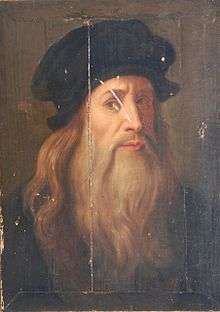Pinxit
Pinxit (from Latin: "one painted") is a stylized amendment added to the signature depiction of the name of the person responsible for a work of art, found conventionally in the Late Middle Ages and the Renaissance. It is sometimes abbreviated P, PIN, or PINX, as in some paintings by Raphael.[1] The locution me pinxit is found on a 12th-century crucifix, not in a sense connected to individual authorship but rather as a more impersonal devotional statement, a "pious [formula] appropriate for liturgical gifts".[2]

Its use by Duccio c. 1255–1260 – c. 1318–1319) on the Maestà in Siena Cathedral is seen as an "audacious" claim by the author, who asserts an individual status on a par with that of the city.[3] By the Late Middle Ages in Venice and elsewhere pinxit (or other forms of pingere, in Gothic lettering) had become customary, and was often found on a cartellino, "any form of fictive paper carrying an inscription", established in Venice by the 1440s. Other verbs used to establish authorship include conjugations of facere ("to make"; fecit ("made by") was frequently used by Titian) or fingere ("to conceive").[4][5]
In 18th century New Spain, artists increasingly included pinxit Mexici (painted in Mexico) on works bound for the European market as a sign of pride in their artistic tradition.[6]
Latin
pinxit is the third-person singular perfect active indicative of pingō, with the meanings: I decorate or embellish; I paint, tint or colour; I portray.
References
- Goffen, Rona (2003). "Raphael's Designer Labels: From the Virgin Mary to La Fornarina" (PDF). Artibus et Historiae. 24 (48): 123–42.
- Schwartz, Michael (1997). "Raphael's Authorship in the Expulsion of Heliodorus". The Art Bulletin. 79 (3): 466–92. JSTOR 3046262.
- Christiansen, Keith (2008). "Duccio and the Origins of Western Painting". The Metropolitan Museum of Art Bulletin. New Series. 66 (1): 1, 6–61. JSTOR 25434148.
- Matthew, Louisa C. (1998). "The Painter's Presence: Signatures in Venetian Renaissance Pictures". The Art Bulletin. 80 (4): 618–48. JSTOR 3051316.
- Prisant, Carol; Jussel, Chris (1999). Antiques Roadshow Primer: The Introductory Guide to Antiques and ... pp. 128–131. ISBN 978-0761116240.
- "Painted in Mexico, 1700–1790: Pinxit Mexici". www.metmuseum.org. The Metropolitan Museum of Art.
This expression eloquently encapsulates the painters' pride in their own tradition and their connection to larger, transatlantic trends.